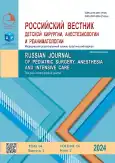Features of diagnosis and treatment of a child with choledochal cyst IС type
- Authors: Sinitsyn A.G.1,2, Perepelkin A.I.1,2, Kopan G.A.1,2
-
Affiliations:
- Volgograd State Medical University
- Clinical Emergency Hospital No. 7
- Issue: Vol 14, No 2 (2024)
- Pages: 257-266
- Section: Case reports
- URL: https://journals.rcsi.science/2219-4061/article/view/263117
- DOI: https://doi.org/10.17816/psaic1796
- ID: 263117
Cite item
Full Text
Abstract
Choledochal cysts are congenital cystic dilatations of the extrahepatic and/or intrahepatic bile ducts. Diagnosis and choice of treatment tactics for this pathology often cause difficulties. A case report of a choledochal cyst in a 2-year-old patient with symptoms of recurrent jaundice, cholangitis, and pancreatitis, which required laparoscopic cholecystostomy and cholangiography during preparation for radical surgery, was retrospectively analyzed. The child was re-admitted to the pediatric surgical department with complaints of hyperthermia up to 39°C, resumption of periodic abdominal pain, nausea, and increased icterus of the sclera and skin. Laboratory and ultrasound examination indicated biliary and pancreatic hypertension. Choledochal cyst, cholestasis syndrome, acute cholecystopancreatitis was diagnosed. Owing to the existing clinical symptoms and laboratory and ultrasound data, laparoscopic cholecystostomy was urgently performed. Against the background of conservative therapy, within 2 days after laparoscopic cholecystostomy, clinically, laboratory and according to control ultrasound examination, biliary and pancreatic hypertension were stopped. The child underwent cholangiography through a cholecystostomy without additional anesthesia, which revealed a fusiform dilatation of the common hepatic and bile ducts. After 2 weeks of drug treatment against the background of laparoscopic cholecystostomy, the child underwent excision of the common bile duct cyst, and cholecystectomy with hepatic enteroanastomosis on a Roux-en-Y loop. The postoperative period was smooth. No other complaints or complications were noted within 24 months. In the reported case, recurrent obstructive jaundice was caused by a choledochal cyst. Laparoscopic cholecystostomy enabled the quick and successful relief of biliary hypertension, preparation of the patient for radical surgical treatment, and safe informative cholangiography through cholecystostomy. Hepatic enteroanastomosis with a disconnected loop according to Roux-en-Y was an effective surgical treatment method for choledochal cyst.
Full Text
##article.viewOnOriginalSite##About the authors
Aleksey G. Sinitsyn
Volgograd State Medical University; Clinical Emergency Hospital No. 7
Email: all-sur04@mail.ru
ORCID iD: 0000-0002-8308-8364
SPIN-code: 3223-7231
MD, Cand. Sci. (Medicine)
Russian Federation, Volgograd; VolgogradAndrei I. Perepelkin
Volgograd State Medical University; Clinical Emergency Hospital No. 7
Author for correspondence.
Email: similipol@mail.ru
ORCID iD: 0000-0001-5964-3033
SPIN-code: 5545-8353
MD, Dr. Sci. (Medicine), Professor
Russian Federation, Volgograd; VolgogradGleb A. Kopan
Volgograd State Medical University; Clinical Emergency Hospital No. 7
Email: gleb.kopan@yandex.ru
ORCID iD: 0000-0002-6627-1028
SPIN-code: 1465-6360
MD, Cand. Sci. (Medicine)
Russian Federation, Volgograd; VolgogradReferences
- Razumovsky AYu, Rachkov VE. Surgery of biliary tracts in children. Manual for doctors. Moscow: GEOTAR-Media; 2020. 216 p. (In Russ.)
- Lee KH, Tam YH, Chan EKW, et al. A twenty-year experience in choledochal cysts in children: from open to laparoscopic excision. HK J Paediatr (New series). 2009;14(3):158–167.
- Morozov DА, Gusev АА, Pimenova ЕS. Bile duct cysts: modern aspects of surgical treatment and clinical observation of a rare case. Current Pediatrics. 2015;14(3):412–415. EDN: UBDZDR doi: 10.15690/vsp.v14i3.1380
- Borisova II, Kagan AV, Karavaeva SA, Kotin AN. Diagnostics and treatment of choledochal cysts in children. Russian Journal of Pediatric Surgery. 2020;24(3):161–166. EDN: TDUBRH doi: 10.18821/1560-9510-2020-24-3-161-166
- Razumovsky AYu. Paediatric surgery: national manual. Moscow: GEOTAR-Media; 2020. 1280 p. (In Russ.)
- Singham J, Yoshida EM, Scudamore CH. Choledochal cysts: Part 2 of 3: Diagnosis. Can J Surg. 2010;52(6):506–511.
- de Vries JS, de Vries S, Aronson DC, et al. Choledochal cysts: age of presentation, symptoms, and late complications related to Todani’s classification. J Pediatr Surg. 2002;37(11):1568–1573. doi: 10.1053/jpsu.2002.36186
- Soares KC, Arnaoutakis DJ, Kamel I, et al. Choledochal cysts: presentation, clinical differentiation, and management. J Am Coll Surg. 2014;219(6):1167–1180. doi: 10.1016/j.jamcollsurg.2014.04.023
- Edil BH, Cameron JL, Reddy S, et al. Choledochal cyst disease in children and adults: a 30-year single institutional experience. J Am Coll Surg. 2008;206(5):1000–1008. doi: 10.1016/j.jamcollsurg.2007.12.045
- Eiamkulbutr S, Tubjareon C, Sanpavat A, et al. Diseases of bile duct in children. World J Gastroenterol. 2024;30(9):1043–1072. doi: 10.3748/wjg.v30.i9.1043
- Razumovsky AYu, Degtyareva AV, Kulikova NV, et al. Laparoscopic surgery for biliary tract malformations in children. Russian Journal of Pediatric Surgery, Anesthesia and Intensive Care. 2012;2(1):19–24. EDN: OZPIMF
- Todani T, Watanabe Y, Toki A, Morotomi Y. Classification of congenital biliary cystic disease: special reference to type IС and IVA cysts with primary ductal structure. J Hepatobilairy Pancreat Surg. 2003;10(5):340–344. doi: 10.1007/s00534-002-0733-7
- Wang P, Gong Y, Lu S, Chen J. Three-dimensional visualization technique compared with magnetic resonance cholangiopancreatography for evaluation of anatomic variants of pediatric congenital choledochal cysts. Pediatr Surg Int. 2021;37(6):705–713. doi: 10.1007/s00383-020-04854-2
- Gezer HÖ. Pediatric choledochal cysts: Unknowns are decreasing. In: Shehata S, editor. Pediatric surgery, flowcharts and clinical algorithms. 2019. doi: 10.5772/intechopen.84301
- Sokolov YuYu, Valiulov IM, Yurkov SV, et al. First experience of laparoscopic resection of choledochal cysts and hepaticojejunoanastomosis in children. Endoscopic surgery. 2007;13(1):79–80. EDN: IAVZCX (In Russ.)
- Razumovskiy AYu, Rachkov VE, Shchapov NF. Low-invasive surgery in treatment of biliary atresia and cysts of the common bile duct. Clinical practice in pediatrics. 2011;6(5):32–39. EDN: OIGHEZ
- Lee H, Hirose S, Bratton B, Farmer D. Initial experience with complex laparoscopic biliary surgery in children: biliary atresia and choledochal cyst. J Pediatr Surg. 2004;39(6):804–807. doi: 10.1016/j.jpedsurg.2004.02.018
Supplementary files









